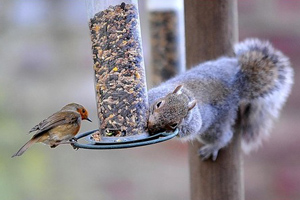Sustainable Wildlife Program
The City of Arlington has a wide range of urban wildlife living in and around beautiful green belts, lakes, streams, and the Trinity River. Arlington is committed to protecting and improving the health and quality of its natural resources.
For decades, Arlington Animal Services (AAS) facilitated the trapping, relocating, or euthanizing of wildlife. Removing wildlife captured in neighborhoods results in a vacuum effect with negative consequences for wildlife and the community.
Studies have shown that relocated animals rarely survive more than two weeks. The relocated animal that is unfamiliar with its new surroundings usually dies of starvation, from injuries inflicted by other wildlife, or other dire circumstances.
AAS is working to educate Arlington residents, business owners, and visitors about urban wildlife. The Sustainable Wildlife Program was initiated to implement proven best practices for harmonious coexistence with wildlife. Support of this program will help attain the best outcome for people, domestic pets, and wildlife in the community.
Let Wildlife Be Wild!
Program Goals
Arlington Animal Services’ mission is “Working together as a community, we will improve the lives of animals.” For those who do not want to have wildlife on their property we have a proactive approach:
- Prevent wildlife from becoming accustomed to people by reducing human/wildlife interaction. This is the first step in letting wildlife be wild.
- Eliminate food, water, and shelter
- Education
Animal Services understands that there are times that trapping, or removal of problem wildlife is warranted. Even with the removal of a nuisance animal this does not stop another animal from moving into its territory. Removal without addressing the underlying source will not stop further problems. We are available to answer questions our web page may not address. Please email questions to animalservices@arlingtontx.gov.
Finally, if you love wildlife, please “Let Wildlife be Wild”. That means don’t provide wild animals with food as that habituates the animal to humans which could make a dangerous situation for people and pets.
Wildlife has survived without our assistance for many generations; just enjoy their beauty from afar and appreciate their ability to be independent and self-sufficient.
If you are not a big fan of wildlife, please “Let Wildlife be Wild”. That means eliminate any attractants to your home or yard, keep your chimney capped, keep landscaping groomed, feed pets indoors or pick up immediately after, and keep trash containers tightly sealed. If you do not attract them, they will stay away.
Sustainable Wildlife Story Map
Why Trapping Will Not Work
There are three main reasons why trapping does not work: the vacuum effect, the availability of resources, and nature's ability to adapt.
The Vacuum Effect
Trapping and removal of wildlife has proven to be ineffective. One of the main reasons is called the vacuum effect, which is simply when you remove an animal, then the next night another animal takes its place.
A 20-year study of urban coyotes by The Ohio State University of the Chicago area in Cook County, Illinois demonstrates the effect of removal of wildlife.
Availability of Resources
The availability of resources is another reason wildlife may be in your neighborhood. Arlington has a very healthy urban ecosystem. Not only do parks, streams, and greenbelts make great habitat, but some backyards do too. Areas underneath sheds, decks, or brush make great homes for many of our wild neighbors. Bird feeders, uncovered trash, vegetable gardens, or pet food that has been left outside provide food for many species.
Nature Will Adapt
Research has found that wildlife will adapt when resources are available in a habitat. Litters are bigger, more of the offspring survive, and the numbers return to normal within a year or less.
Wild Furbearer Conservation and Management in North America (Novak et al, 1987) provides data demonstrating that when raccoons exhibit low reproductive rates, as much as 49% of the population can be trapped out and they will rebound back to their former level by the next breeding season. When raccoons exhibit high reproductive rates (typical with an ongoing trapping program), as much as 59% of the population can be trapped out and the population will replace itself by the next birthing season. A similar scenario has been observed among coyotes and groundhogs.
For more information, visit 911wildlife.com.
Steps to Reduce Wildlife at Home

- Let wildlife be wild;
- Do not intentionally feed wildlife;
- Keep trash containers tightly sealed;
- Keep landscaping well groomed;
- Feed pets indoors or at least pick up any remaining food after they eat;
- Do not leave birdseed in feeders or on the ground overnight;
- If you have a pet door, close it securely at night;
- Trim overhanging branches that provide easy access to your roof for squirrels and other wildlife;
- Cover crawlspace and attic openings with heavy gauge, rustproof wire mesh (not chicken wire);
- Carefully inspect your eaves and other areas where the roof and house join. Repair deteriorating boards, warped siding and loose shingles;
- If you have a chimney, make sure that it has a secure cap because chimneys without caps are open invitations to raccoons looking for “hollow trees” in which to give birth and raise their young;
- If you have a deck, you can prevent animals from digging underneath it by creating an L-shaped barrier. Attach heavy gauge wire mesh to the base of the deck, sink it six inches into the ground, bend it 90 degrees away from the deck for 12 inches and then cover it with soil.
Learn more about Urban Wildlife.